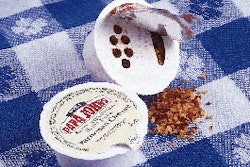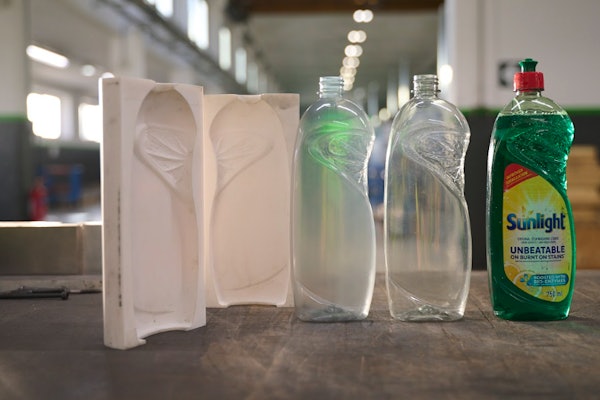Some packaging suppliers are just a little concerned that the EPA's upcoming rule--called a MACT--limiting emissions during coating and laminating operations may end up rhyming with smacked, as in: "I just got smacked in the head by the EPA." MACTs (maximum achievable control technology) dictate required limits on emissions of any of 188 hazardous air pollutants (HAPs). The MACT for which the EPA is currently gathering data is for a sector defined as "paper and other web coatings" (POWCs). Key HAPs of concern are Toluene and MEK. The POWC MACT will affect a wide variety of packaging operations where HAPs come into play as adhesives for laminate layers, and as solvents for coatings. Manufacturers of pressure-sensitive tapes and labels will also be affected. A final rule is expected in the year 2000 with compliance required a few years thereafter. The EPA held its latest stakeholder meeting with interested trade associations on June 4. Attendees included representatives from companies such as Reynolds Metals, Rollprint Packaging, Curwood-Bemis, American National Can, Lawson Mardon, Mebane Packaging, RJR Packaging and many others. The agency is concerned that it has insufficient emissions and control data for some packaging sectors, according to Trish Koman, the EPA official in charge of the rulemaking. This knowledge gap, which some EPA officials believe could be closed if some foot-dragging sectors woke up, could lead to a more onerous rule than might actually be necessary. Second MACT truck? The POWC MACT follows closely on the heels of a related MACT for printing and publishing (P&P). It was finalized in 1996 and takes effect in 1999. Many companies that print packaging on gravure and flexographic presses spent millions of dollars on in-plant control equipment and on new product development to bring facilities into compliance with the P&P MACT. Some of those same companies will be affected by the POWC MACT, this time because of emissions from their laminating and paper, plastic, film and foil coating lines, which often sit side-by-side with the gravure and flexo presses, and can feed into the same emission control equipment. So if the EPA decides to set more stringent emission limits for the POWC HAPs, companies such as Lawson Mardon Packaging (Northbrook, IL) could be in big trouble. Added Expenditures "We could have substantial additional expenditures," says Dennis Coil, environmental manager for North America at Lawson Mardon, which has seven plants in the U.S. Those facilities print and coat food packaging. Coil explains that the company spent several million dollars over the past two or three years coming into compliance with the P&P MACT. An executive at another major company that both manufactures and prints packaging at five plants around the country adds, "Separate emission limits for those two MACTs would be absolutely devastating." Here is the threat. The "destruction level" under the P&P MACT is 95%. But the EPA has said that thermal oxidizers with permanent total enclosure yield 98% destruction rates on coating lines. Trish Koman says, "A ninety-eight-percent destruction rate is a possibility because that is the technology many companies are already using. But our data is incomplete. We still need data about the emissions and controls on coating lines at companies who make and print flexible packaging." The EPA is sensitive to the potential for a "double whammy" on companies that would have to comply with different P&P and POWC emission limits. That is why it has been working hard to gather data from industry that would justify mirroring HAP emission levels for the POWC MACT on those already in effect, as of 1999, for the P&P MACT. "The EPA has been very cooperative," states Coil. The EPA's Koman says some packaging sectors have been more cooperative than others in providing data. She says flexible packagers, for example, have been very forthcoming. Others have been less helpful. "We can only be as sensitive as the data we receive," she explains. HAPs vs VOCs The EPA's job is complicated by the fact it is conducting a second rulemaking parallel to the POWC MACT, this one aimed at reducing emissions of volatile organic compounds (VOCs) during the coating of paper, film and foil packaging. This rulemaking includes sheet-fed products, while the POWC category includes only web products. Koman says many of the VOCs are counted among the 188 HAPs. Of course there are literally thousands of VOCs. To the extent that the POWC MACT and the VOC rule will affect generally the same group of companies and require them to control their converting equipment, the two rules are similar. But there are a number of key differences, too. The MACT will be a national standard; any company that is a "major source" of HAPs will have to abide by emission limits, which will be proposed for public comment in the fall of 1999. Companies who are affected will have to obtain state permits to operate. A major source is defined as a company that uses more than 10 tons/year of one HAP, or more than 25 tons/year of more than one HAP. The VOC rule is a little different. The EPA has the option of either publishing a national rule or publishing what is called a control technique guideline (CTG). CTGs are probably more likely. The states would then use those CTGs as the basis to write their own rules, called RACTs, for "reasonably available control technology." But compliance would be required only for companies with a facility (regardless of whether it is a major source) in ozone non-attainment areas, which translates to the large urban areas. Some packaging manufacturers will be subject to only the MACT, others to only the CTGs, and still others to both. The EPA wants to make compliance as easy as possible for those in the third category, which is why these two rulemakings have been integrated. Moreover, some of those companies subject to the POWC MACT will have already fallen under the P&P MACT. Koman says the agency would also like to minimize the headaches and confusion, particularly in the area of recordkeeping, for companies that will be subject to both MACTs. "We don't want them to have the heartbreak of keeping two sets of books," she explains. Again, the EPA's ability to, in Koman's terms, "harmonize" the two MACTs, and the POWC MACT and the VOC rule, depends on the quality and quantity of data it gets from the various packaging sectors.























